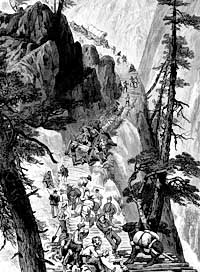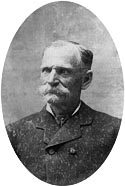 |
|
|
Follow Mark on Facebook for more stories |
||
|
Chapter Two: Black Bart: Sierra Stage Robber It took western lawmen eight long years to nab the most noted of all 19th century Sierra stagecoach robbers. Time enough for the legendary "Black Bart" to pull off a record twenty-eight hold-ups. Bart's reign of terror lasted the better part of a decade because no one could identify the mysterious lone bandit who dared waylay Wells Fargo stages all by himself. Bart was a most improbable highwayman. He was skinny, short and bald, and didn't even own a horse. He walked to his crimes, carrying a shotgun so old and rusty that it wouldn't shoot. In fact, the weapon was never loaded. Black Bart always worked alone, although he would frequently create decoy gunmen for back-up, placing wooden sticks on boulders to stimulate their rifles. Bart's strategy was deceptively simple psychology. He would wait at a dangerous bend in the road where the stage was forced to creep along slowly. At just the right moment, he emerged as an apparition in the deepening twilight. To enhance his supernatural qualities, Bart wore a long white linen duster over his clothes. A ghostly flour sack covered his head and derby hat, with two holes cut out for eye slits. In a "deep and hollow voice" Bart would command the trembling stagec Bart was considered a gentleman by most of his victims; his focus seemed to be the Wells Fargo money box and the U.S. Mail. Well-known as an extremely courteous bandit, Bart refused to steal women's jewelry and avoided gun play at all costs. Some people sympathized with Black Bart. California, like much of the United States, was in the grip of a severe economic depression in the 1870s. The powerful Bank of California collapsed in August 1875, taking with it many financial institutions and businesses. At the same time, mining stocks plummeted on the San Francisco Stock Exchange. Drought forced thousands of farmers and farm laborers to seek work in the cities. There were ten thousand hungry workingmen on public relief in San Francisco alone; other men were fighting for jobs that paid only two dollars a day. Crime replaced industry, and the decade became known as the "Era of Good Stealing." Between November 1870 and November 1884, the total amount taken from Wells Fargo by stage robbers, train bandits, and burglars was in excess of $415,000. Black Bart was not the first man to rob a California stagecoach; that bold deed was accomplished in 1856 by Tom Bell, whose story must be told another day. Bart's life of crime began July 1875, when he held up a Wells Fargo express stage with a double-barreled shotgun. No one was hurt, but Bart's booty was $300 in gold coin. Unlike other road agents, Black Bart was patient. He did not strike again until the following summer, when he robbed another stage near Quincy, California. It was a modest start, but the seemingly insignificant, random hold-ups were only the beginning of Black Bart's legacy. For the next eight years, Bart pulled heists from Shasta, in the north, to Fort Ross on the Sonoma coast, but he preferred to haunt the Wells Fargo stage routes throughout the Sierra Nevada gold country. He never fired a shot and always got the "box." In his fourth robbery, Bart wrote a short poem which he left in the cleaned out money box. He signed this note "Black Bart – The PO8." Evidently, Bart considered his short rhyming missives to be "PO8ry." After his fifth hold-up, the poet laureate of road agents left the last poem he would leave at the scene of a crime: Here I lay me down to sleep Let come what will, I'll try it on Wells Fargo detectives said that the handwriting proved the "Black Bart" bandit had extensive experience in clerical work and declared that they would find the cocky criminal soon. An $800 reward was posted for Black Bart's arrest and conviction. Despite this incentive and a well-organized search by Wells Fargo's Chief of Detectives, James B. Hume, Bart began to steal with impunity. He seemed to be everywhere. Black Bart had a unique ability to travel extraordinary distances in impossibly short periods of time. J.B. Hume could barely keep up with the widely-scattered hold-ups. At least Bart acted like a gentleman. In order to calm their passengers, the Wells Fargo Company published a statement about the bandit's modus operandi; "He has never manifested any viciousness and there is reason to believe he is averse to taking human life. He is polite to all passengers, and especially to ladies. He comes and goes from the scene of the robbery on foot; seems to be a thorough mountaineer and a good walker." By 1883, Black Bart had become a romantic legend in California, but his luck was about to change. The morning of November 3, 1883, dawned clear and cold. Reason McConnell, driver for the Nevada Stage Company, was hauling nearly five thousand dollars in gold dust and coin. His only passenger was nineteen-year-old Jimmy Rolleri, who was keeping McConnell company on the ride over Funk Hill, near the Stanislaus River. The horse-drawn carriage slowed as it climbed the ridge, and Jimmy jumped off. He had his Henry rifle and wanted to see if he could shoot a rabbit, or a deer if he was lucky. The horses slowly plodded up the steep grade, until, just before the crest, Black Bart appeared out of the bushes. Bart had been here before. He had committed his first robbery at this very spot on July 26, 1875. Black Bart ordered McConnell to throw down the gold box, but this time the Wells Fargo chest was bolted to the floor of the stagecoach. While Bart took an axe to the lock on the box, Jimmy Rolleri quietly emerged from the brush. When the road agent backed out of the coach holding a heavy sack of gold and a bundle of mail, Jimmy and his trusty rifle were waiting for him. As soon as he saw the armed teenager, Bart dove into the underbrush and ran for his life. McConnell grabbed Jimmy's gun and fired two shots at the fleeing bandit. Both rounds missed. At that Jimmy said, "Here, let me shoot. I'll get him, and I won't kill him, either." Jimmy's bullet hit Bart in the hand, forcing him to drop the mail, but the fleet-footed thief disappeared into the thicket still carrying the sack of gold. Bart stashed the loot, tramped one hundred miles through rugged, overgrown country in three days, and then boarded an eastbound train for Reno to hide out. Later in the week, he returned to California. Black Bart may have escaped, but this time he left incriminating evidence behind, most damaging of which was a handkerchief Chapter Nine: Selected Sources
|
|||
|

 oach driver to "Throw down the box!" Drivers knew
that he meant the valuable Wells Fargo security chest. For stage drivers in the mountains, Bart's spooky reputation unnerved the most stoic of them. In order to further his ruse, Bart would
often call out to his imaginary gang, "If he dares to shoot, give him a solid volley, boys!"
oach driver to "Throw down the box!" Drivers knew
that he meant the valuable Wells Fargo security chest. For stage drivers in the mountains, Bart's spooky reputation unnerved the most stoic of them. In order to further his ruse, Bart would
often call out to his imaginary gang, "If he dares to shoot, give him a solid volley, boys!"
 with a San Francisco laundry mark on it. Exhaustive detective work by Harry N. Morse, ex-sheriff of
Alameda County, eventually led J.B. Hume to Charles E. Boles, a retired mining engineer and well-respected gentleman of San Francisco. Hume and Morse interrogated and then arrested
Boles. On November 16, 1883, Boles pled guilty to the last robbery and returned the loot. He was convicted but sentenced to only six years in San Quentin Prison in return for his cooperation and
good behavior. The unassuming Boles didn't drink or smoke; in fact, his worst vice was coffee. His background was somewhat of a mystery. Born in England he came to California twice
during the Gold Rush, but returned to the Midwest, married, and enlisted in the Union Army. He fought in the Civil War for three years and was seriously wounded in Georgia. Boles returned to duty as a
first sergeant and was later commissioned a second lieutenant. Charles Boles was a distinguished soldier, but a lousy family man. After the war, he abandoned his wife and three daughters for the
western mining country. His family had not heard from him in years and concluded that he had been killed by Indians. Charles Boles served about four years in San Quentin before being released on
January 21, 1888. He was fifty-four years old. Boles disappeared after that until Detective Hume heard in 1900 that the old man had died while hunting game in the High Sierra. Black Bart may be gone,
but his legend endures.
with a San Francisco laundry mark on it. Exhaustive detective work by Harry N. Morse, ex-sheriff of
Alameda County, eventually led J.B. Hume to Charles E. Boles, a retired mining engineer and well-respected gentleman of San Francisco. Hume and Morse interrogated and then arrested
Boles. On November 16, 1883, Boles pled guilty to the last robbery and returned the loot. He was convicted but sentenced to only six years in San Quentin Prison in return for his cooperation and
good behavior. The unassuming Boles didn't drink or smoke; in fact, his worst vice was coffee. His background was somewhat of a mystery. Born in England he came to California twice
during the Gold Rush, but returned to the Midwest, married, and enlisted in the Union Army. He fought in the Civil War for three years and was seriously wounded in Georgia. Boles returned to duty as a
first sergeant and was later commissioned a second lieutenant. Charles Boles was a distinguished soldier, but a lousy family man. After the war, he abandoned his wife and three daughters for the
western mining country. His family had not heard from him in years and concluded that he had been killed by Indians. Charles Boles served about four years in San Quentin before being released on
January 21, 1888. He was fifty-four years old. Boles disappeared after that until Detective Hume heard in 1900 that the old man had died while hunting game in the High Sierra. Black Bart may be gone,
but his legend endures.